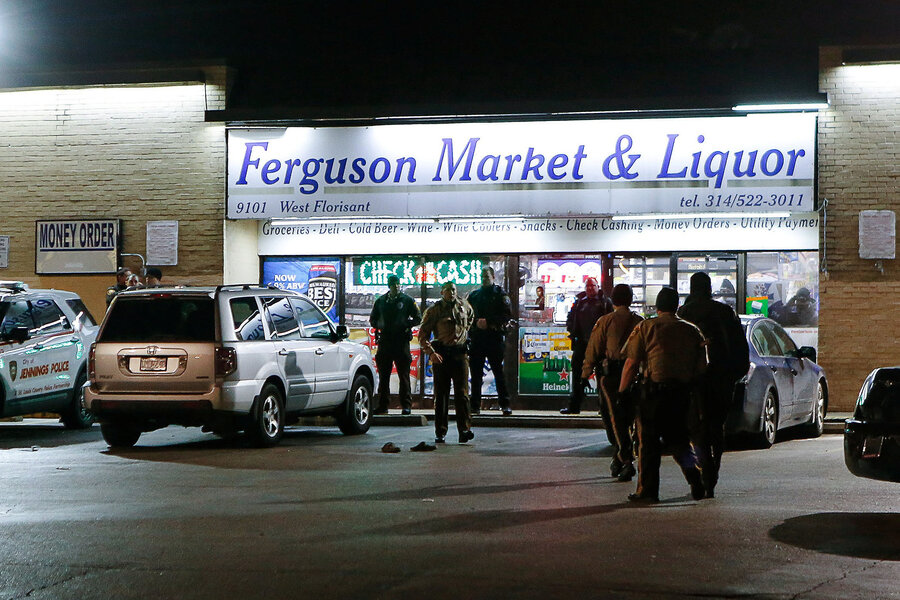What new video reveals about the Michael Brown shooting
Loading...
Previously unreleased video of Michael Brown hours before he was shot by police in 2014 has a documentary filmmaker and an attorney for the convenience store at odds over the significance of the footage.
One of the filmmakers, Jason Pollock, told The New York Times that the bag Mr. Brown is seen leaving on the counter contains marijuana, a trade with the clerk for cigarillos that Mr. Brown left behind. But Jay Kanzler, a lawyer for Ferguson Market & Liquor, said no such barter took place, and promised to release an unedited version of the video to prove it.
It is unlikely the video will change the outcome of the investigation into the Brown shooting, as authorities have said they focused on the encounter between Mr. Brown and Ferguson, Mo., police officer Darren Wilson. But the video has prompted a wave of questions over what brought Brown back to the store just before his death, and whether he stole the mini-cigars, as police suspected.
The security footage, part of a Saturday premiere of the documentary “Stranger Fruits,” shows Brown entering the convenience store around 1 a.m. on Aug. 9. 2014, nearly 10 hours before his death. He approaches the counter, hands over an item that appears to be a small bag, and takes a shopping sack filled with cigarillos. After walking toward the door with the sack, Brown turns around and hands the cigarillos back across the counter before he leaves the store.
Security footage police released less than a week after the shooting in 2014 shows Brown returning to the store hours later, shortly before his death. In the video, Brown is seen taking cigarillos from the counter and pushing the store clerk who confronts him at the entrance. Police have characterized the incident as a strong-armed robbery.
Mr. Wilson, the police officer who shot and killed Brown on a Ferguson street, testified to a grand jury that the encounter started when he was trying to confront Brown and a friend who were walking in the middle of the street, The Christian Science Monitor previously reported. Wilson said he saw that Brown was carrying mini-cigars and suspected that the two might have been involved in a convenience store robbery of cigarillos that had been reported by police radio.
But Mr. Pollock, the filmmaker, suggest that Brown left the cigarillos, part of what he says is the marijuana deal, behind the counter for safekeeping. He told the Times the footage, then, challenges the police narrative that Brown committed a strong-armed robbery when he returned to the store that day.
Mr. Kanzler, the store's attorney disagrees.
"There was no understanding. No agreement. Those folks didn't sell him cigarillos for pot. The reason he gave it back is he was walking out the door with unpaid merchandise and they wanted it back," he told the St. Louis Post-Dispatch.
Kanzler added that the footage had been seen by authorities, prosecutors, and Brown’s family, and that the documentary version was edited.
“The video has been out there,” Kanzler said. “This isn’t new.”
Some local police who investigated the shooting told the Post-Dispatch they didn’t think the video shed much light on the case.
St. Louis County Police Chief Jon Belmar told the newspaper he wasn't surprised that Brown was in the Ferguson Market earlier in the day. Belmar said his department focused on investigating the shooting, not the incident at the store.
Former Ferguson Police Chief Tom Jackson said he hadn't seen the earlier surveillance video, but that he didn't think it was fair to connect the store to a drug transaction.
But about 100 protesters gathered outside the store on Sunday night.
In his grand jury testimony, Wilson said he fired his handgun at Brown in that 2014 encounter because he feared for his life. Wilson described Brown as having an angry and intense expression, the Monitor previously reported.
Brown was “just coming straight at me like he was going to run right through me. And when he gets about ... 8 to 10 feet away ... all I see is his head and that's what I shot," Wilson testified.
A grand jury found in November 2014 no “probable cause” to charge Wilson with murder, or with voluntary or involuntary manslaughter. Police under Missouri law may use deadly force if they “reasonably believe” themselves or others to be in imminent danger.
County prosecutor Robert McCulloch said at the time that Wilson’s own testimony should not be given too much weight, since he was the target of the investigation. But the prosecutor suggested the grand jury came to its conclusion because the evidence and other testimony to Wilson’s self-defense claim were consistent and compelling.
The shooting and protests did lead to a Justice Department investigation into the city of Ferguson, resulting in a report that alleged racial bias in the city's criminal justice system.
This report contains material from the Associated Press.







